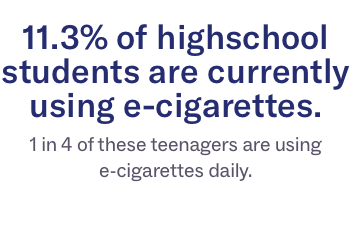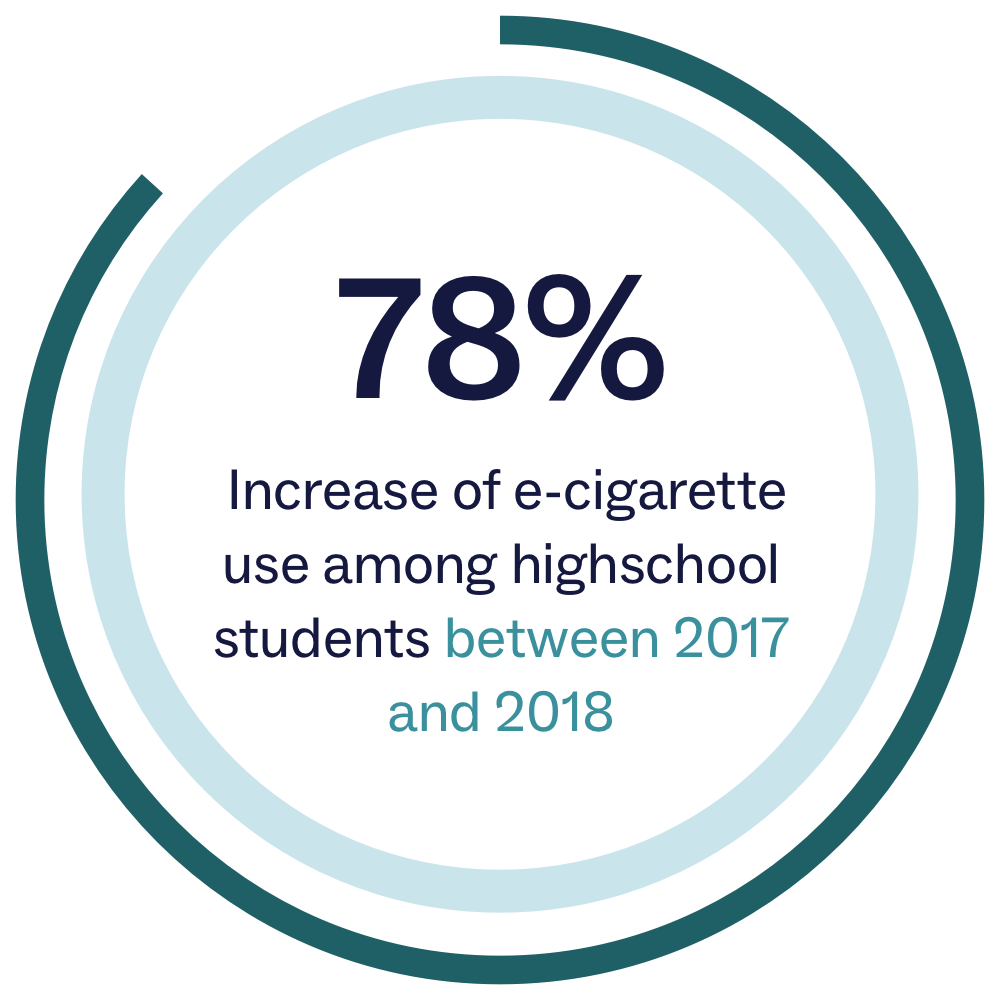
Table of Contents
Vaping & Teen Health: What You Need to Know

Written By: Colin Crouse

Clinically Reviewed By: Dr. Jaime Ballard
November 7, 2022
6 min.
The use of e-cigarettes, or vaping, is increasingly popular among teens and young adults. The physical side effects of vaping have been studied, but we are now beginning to understand the mental health effects as well.
Learn more about our Clinical Review Process
Table of Contents
What Are E-Cigarettes?
Electronic cigarettes, commonly referred to as “vapes,” are battery powered devices that deliver vapor to users by heating a liquid solution containing nicotine, also known as e-liquid. E-cigarettes come in a variety of sizes, shapes, and flavors. Due to their increasing popularity, e-cigarettes are widely available throughout the country.
E-cigarette use among adolescents and young adults
Electronic cigarettes are the most commonly used nicotine products among youth. They are continuing to gain popularity due to a wide array of enticing flavors, as well as the belief that they are safer than traditional tobacco products such as cigarettes.
In reality, nicotine, the active ingredient in e-liquid, is one of the top 5 most addictive drugs in the world. The FDA has reported a drastic increase in e-cigarette use among adolescents in recent years, designating it an “epidemic” among youth. Between 2017 and 2018, e-cigarette use among high school students exponentially increased by 78%.
While it is illegal to sell electronic cigarettes to minors in the United States, as of 2021, the CDC estimates that 11.3% of high school students are currently using e-cigarettes. Approximately one in four of these teenagers are using e-cigarettes daily. Among the two million high school and middle school students surveyed by the CDC who use e-cigarettes, almost 85% of them were using flavored e-liquid. Additionally, a 2019 study that focused on one college found that approximately 25% of the total undergraduate population was using e-cigarettes. A separate study of a different college campus determined that 22% of their undergraduate population were using e-cigarettes.

Types of e-cigarettes
Reusable e-cigarettes
Reusable e-cigarettes, often referred to as “box mods” or “tank mods,” are generally large devices with refillable tanks. These devices are refilled by inserting e-liquid directly into the tank using a small dropper. These devices, as well as bottles of e-liquid with varying nicotine concentration and flavors, are easily accessible at tobacco shops, gas stations, online vendors and new “vape shops” all across the country.
It should also be noted that reusable e-cigarettes can be potentially hazardous, with multiple accounts of children suffering from traumatic injuries due to explosions or fires caused by overheating chargers or the devices’ batteries.
Cartridge e-cigarettes
Cartridge e-cigarettes are rechargeable devices with refillable or disposable cartridges (often referred to as “pods”). Perhaps the most notable cartridge e-cigarette brand is JUUL, which has been banned nationwide by the FDA as of June 2022 due to safety concerns*. Leading up to this ban, the FDA in 2020 banned several of flavored cartridges offered by JUUL such as mint, cucumber, mango and fruit due to concerns that these flavors were encouraging e-cigarette use in teenagers. The Silicon Valley-based brand has been widely criticized for igniting an epidemic of adolescent e-cigarette use in America. Furthermore, JUUL has been accused of directly targeting youth in their marketing campaigns through both social and traditional media.
*It should be noted that as of July 5 2022, the FDA has placed an administrative hold on the ban of JUUL products, pending further scientific review.
Disposable e-cigarettes
Disposable electronic cigarettes generally tend to be small, discreet devices. These e-cigarettes are non-rechargeable and come pre-filled with e-liquid. Disposable e-cigarettes are the most popular e-cigarettes among users, likely because they are small, inexpensive, discreet, and often deliver high concentrations of nicotine in a single puff. Many disposable e-cigarettes come in a variety of fruity and dessert-themed flavors that may seem enticing to adolescents and young adults. Some examples of popular e-cigarette flavors on the market include strawberries and cream, mint, lemon lime, green, pineapple and watermelon. Disposable e-cigarettes can be found in tobacco shops, vape shops, gas stations, convenience stores. They are also easily accessible from online vendors.
Risks of e-cigarette use
Mental health impacts of e-cigarette use
While a traditional cigarette contains an average of 12 mg of nicotine, some electronic cigarette e-liquids have been found to contain upwards of 30 mg/mL of nicotine. Being that nicotine is an extremely addictive drug, this raises major health concerns––young peoples’ brains are already more impressionable and therefore at a higher risk of addiction than older adults with fully developed brains. While teens and adolescents may turn to using e-cigarettes as a way to relieve stress or to cope with the symptoms of mental health conditions such as anxiety, the use of nicotine in general has been associated with the development or exacerbation of multiple psychological conditions.
E-cigarette use has been associated with psychological conditions such as:
- Anxiety
- Insomnia
- Depression
- Substance use disorders
- Mood disorders
- Poor impulse control
- Reduced attention and thinking skills
Furthermore, according to the CDC, adolescents who use e-cigarettes are more at risk to smoke traditional cigarettes later in life.
Physical impacts of e-Cigarette use
Aside from the concern of nicotine addiction and other psychological conditions, electronic cigarettes have the potential to cause harmful effects on the lungs of e-cigarette users. A 2015 Harvard study found that 75% of flavored e-liquids examined by researchers contained a toxic chemical known as diacetyl. When inhaled, diacetyl has been linked to the severe respiratory disease bronchiolitis obliterans, popularly referred to as “popcorn lung.” Popcorn lung may cause inflammation of the lungs’ bronchioles, which can lead to lung tissue scarring, coughing, and shortness of breath. Medical professionals at Johns Hopkins have also reported a “rash of collapsed lungs in younger people,” from the use of e-cigarettes containing hazardous toxins such as diacetyl and formaldehyde. Other toxins such as heavy metal particulates have also been detected in e-cigarette vapors, which may cause further damage to adolescents and young adults whose lungs continue to develop into their early to mid 20s.
Heavy metal particulates that have been discovered in e-cigarettes:
- Nickel
- Aluminum
- Lead
- Tin
- Zinc
These tiny metal particles are especially dangerous because they have the potential to penetrate deep into the lungs and cause further damage.
Other physical impacts of e-cigarette use include:

What is nicotine withdrawal?
Nicotine withdrawal occurs when someone stops using a nicotine product, such as e-cigarettes or chewing tobacco, for a prolonged period of time. On average, withdrawal symptoms can last between two to four weeks. However, withdrawal might last longer based on how long someone has been using nicotine. Nicotine withdrawal has been associated with a variety of symptoms such as nicotine cravings, restlessness, irritability, insomnia, anxiety, depression, headaches, trouble concentrating, fatigue, and increased appetite. While these symptoms can often be very uncomfortable, there are several ways to minimize the effects of nicotine withdrawal.
Coping With Nicotine Withdrawal
Unfortunately, many e-cigarette users experience nicotine withdrawal symptoms after they quit. Experts agree on a variety of ways to curb withdrawals and cravings. Here are some of the best ways to combat the uncomfortable symptoms of nicotine withdrawal:
- Nicotine cessation therapy
- Exercise
- Yoga
- Meditation
- Mindfulness practices such as deep breathing exercises.
- Chewing gum or hard candy to keep your mouth busy.
Vaping & teen health
While e-cigarettes are immensely popular among young adults and adolescents, we still have much to learn about them and how they might impact the long term physical and mental health of our youth. Although they’re often marketed as a safe alternative to conventional tobacco products such as cigarettes, e-cigarettes come with their own list of safety concerns such as higher nicotine concentrations, exposure to toxins, and the development of popcorn lung in some users. Aside from the physical health concerns, several studies have linked the use of e-cigarettes to mental health conditions such as anxiety, depression, insomnia and many more in young adult and adolescent users who are more at risk of developing these disorders than adults.
Furthermore, the e-cigarette industry has been widely criticized for tailoring their products to children by marketing flavors that resemble fruity snacks, desserts, and breakfast cereals. Some e-cigarette companies have even been directly accused of deploying marketing campaigns that specifically target our nation’s youth through traditional and social media, further contributing to what the FDA has declared an “epidemic” of e-cigarette use among youth.
Substance use support at Charlie Health
If you or a loved one is struggling with e-cigarette dependence, suffering from nicotine withdrawals, or would like additional information on e-cigarettes, Charlie Health’s IOP may be able to help. Reach out today.
References
What is the Most Addictive Drug? Here Are the Top 5 Substances. (n.d.). American Addiction Centers. Retrieved October 20, 2022, from https://americanaddictioncenters.org/adult-addiction-treatment-programs/most-addictive
What Does Vaping Do to Your Lungs? (2021, October 15). https://www.hopkinsmedicine.org/health/wellness-and-prevention/what-does-vaping-do-to-your-lungs
https://www.lung.org/lung-health-diseases/how-lungs-work/lung-capacity-and-aging#:~:text=Your%20lungs%20mature%20by%20the,difficult%20as%20you%20get%20older.
What Is Popcorn Lung? (n.d.). WebMD. Retrieved October 7, 2022, from https://www.webmd.com/lung/popcorn-lung
Commissioner, O. of the. (2020, March 24). FDA finalizes enforcement policy on unauthorized flavored cartridge-based e-cigarettes that appeal to children, including fruit and mint. FDA; FDA. https://www.fda.gov/news-events/press-announcements/fda-finalizes-enforcement-policy-unauthorized-flavored-cartridge-based-e-cigarettes-appeal-children
Galderisi, A., Ferraro, V. A., Caserotti, M., Quareni, L., Perilongo, G., & Baraldi, E. (2020). Protecting youth from the vaping epidemic. Pediatric Allergy and Immunology: Official Publication of the European Society of Pediatric Allergy and Immunology, 31 Suppl 26, 66–68. https://doi.org/10.1111/pai.13348
FDA orders Juul e-cigarettes off the market over safety concerns. (n.d.). Washington Post. Retrieved October 6, 2022, from https://www.washingtonpost.com/health/2022/06/23/juul-banned-fda/
Kirkham, C., & Venugopal, A. (2022, June 24). U.S. bans sales of Juul e-cigarettes, company to seek stay on enforcement. Reuters. https://www.reuters.com/world/us/us-fda-halts-sales-juul-e-cigarettes-2022-06-23/
Jenssen, B. P., Walley, S. C., SECTION ON TOBACCO CONTROL, Groner, J. A., Rahmandar, M., Boykan, R., Mih, B., Marbin, J. N., & Caldwell, A. L. (2019). E-Cigarettes and Similar Devices. Pediatrics, 143(2), e20183652. https://doi.org/10.1542/peds.2018-3652
E-cigarette, or vaping, products visual dictionary. (2019, December 13). Retrieved October 4, 2022, from https://stacks.cdc.gov/view/cdc/103783
The Federal Trade Commission’s First Report on E-Cigarette Sales and Advertising Reveals Disturbing Trends Affecting the Health of Young Americans. (2022, March 17). Federal Trade Commission. https://www.ftc.gov/news-events/news/press-releases/2022/03/federal-trade-commissions-first-report-e-cigarette-sales-advertising-reveals-disturbing-trends
Talking to Youth and Young Adults to Prevent E-cigarette Use. (2021, December 1). https://www.cdc.gov/tobacco/features/back-to-school/index.html
Boston, 677 Huntington Avenue, & Ma 02115 +1495‑1000. (2015, December 8). Chemicals linked with severe respiratory disease found in common e-cigarette flavors. News. https://www.hsph.harvard.edu/news/press-releases/e-cigarette-flavoring-chemicals-linked-to-respiratory-disease/
Committee on the Review of the Health Effects of Electronic Nicotine Delivery Systems, Board on Population Health and Public Health Practice, Health and Medicine Division, & National Academies of Sciences, Engineering, and Medicine. (2018). Public Health Consequences of E-Cigarettes (K. Stratton, L. Y. Kwan, & D. L. Eaton, Eds.; p. 24952). National Academies Press. https://doi.org/10.17226/24952
Tips for Coping with Nicotine Withdrawal and Triggers—NCI (nciglobal,ncienterprise). (2022, January 13). [CgvArticle]. https://www.cancer.gov/about-cancer/causes-prevention/risk/tobacco/withdrawal-fact-sheet
Nicotine Withdrawal: Tips to Getting Through It. (n.d.). WebMD. Retrieved September 14, 2022, from https://www.webmd.com/smoking-cessation/nicotine-withdrawal-tips;
Products, C. for T. (2022). E-Cigarettes, Vapes, and other Electronic Nicotine Delivery Systems (ENDS). FDA. https://www.fda.gov/tobacco-products/products-ingredients-components/e-cigarettes-vapes-and-other-electronic-nicotine-delivery-systems-ends
The Real Cost of Vaping. (n.d.). Retrieved September 15, 2022, from https://www.scholastic.com/youthvapingrisks/
Barboza, D. (2014, December 13). China’s E-Cigarette Boom Lacks Oversight for Safety. The New York Times. https://www.nytimes.com/2014/12/14/business/international/chinas-e-cigarette-boom-lacks-oversight-for-safety-.html
Russell, K. W., Katz, M. G., Phillips, R. C., Kelley-Quon, L. I., Acker, S. N., Shahi, N., Lee, J. H., Fialkowski, E. A., Nacharaju, D., Smith, C. A., Jensen, A. R., Mueller, C. M., Padilla, B. E., Ignacio, R. C., Ourshalimian, S., Wang, K. S., Ostlie, D. J., Fenton, S. J., & Kastenberg, Z. J. (2022). Adolescent Vaping-Associated Trauma in the Western United States. Journal of Surgical Research, 276, 251–255. https://doi.org/10.1016/j.jss.2022.02.026
Dunbar MS, Tucker JS, Ewing BA, Pedersen ER, Miles JNV, Shih RA, & D’Amico EJ (2017). Frequency of E-cigarette Use, Health Status, and Risk and Protective Health Behaviors in Adolescents. Journal of Addiction Medicine, 11(1), 55–62. [PubMed: 27898495]
Jones, R. D., Asare, M., & Lanning, B. (2021). A Retrospective Cross-Sectional Study on the Prevalence of E-cigarette Use Among College Students. Journal of Community Health, 46(1), 195–202. https://doi.org/10.1007/s10900-020-00869-x


